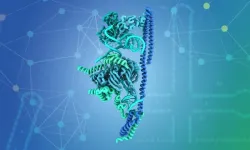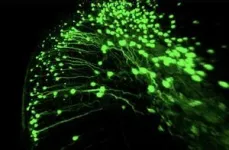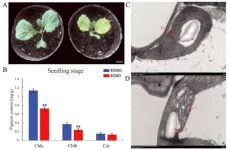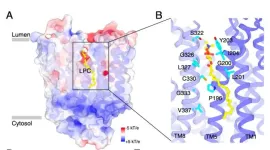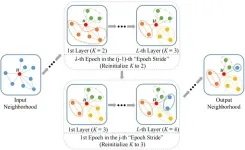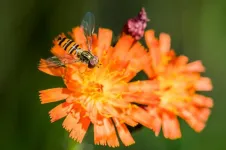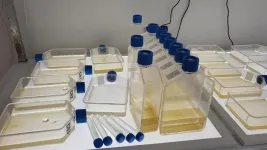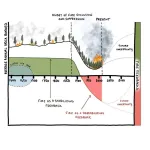(Press-News.org) In human cells, only a small proportion of the information written in genes is used to produce proteins. How does the cell select this information? A large molecular machine called the spliceosome continuously separates the coding and non-coding regions of our genes – and it's doing this even as you read these lines.
The spliceosome is critical for the proper functioning of every cell, and numerous genetic disorders are linked to problems with spliceosome function. In most eukaryotic cells, two types of spliceosome work in parallel to stitch gene pieces together: the major spliceosome and the minor spliceosome.
The Galej Group at EMBL Grenoble has recently published new structural insights into minor spliceosome function in the journal Molecular Cell.
The major spliceosome is abundant in cells and has been extensively investigated for more than four decades. Its long-separated twin – the minor spliceosome, is much more scarce and remains enigmatic, even though its function is equally important. In this new study, the researchers reveal the structure of U11 snRNP – one of the five subunits of the minor spliceosome, which initiates the intron selection process.
Stitching gene pieces together
Spliceosomes help cells remove large chunks of non-coding genetic information – called introns – from the precursors of messenger RNA (pre-mRNA), the molecule responsible for transferring genetic information from DNA into proteins. Spliceosomes act as an editing tool, helping to make sense of the fragmented messages stored in pre-mRNA.
Most genes have many introns that belong to one class – the major introns – which are removed by the major spliceosome. However, around 0.5% of introns belong to another class – the minor introns – which are processed by the minor spliceosome.
“These minor introns are very rare but extremely critical because they are often located in housekeeping genes that are essential for supporting life,” said Jiangfeng Zhao, a postdoctoral fellow in the Galej Group and the first author of the study.
Spliceosomes are large and dynamic RNA-protein complexes. The major spliceosome consists of five subunits, U1, U2, U4, U6, and U5 small nuclear ribonucleoprotein particles (snRNPs, read “snurps”) – and about 150 proteins, involved in different stages of the splicing process. The minor spliceosome has a similar architecture, but its main building blocks are different (U11, U12, U4atac, U6atac, and U5 snRNPs). How exactly these blocks assemble to build the minor spliceosome and help it fulfil its function remains elusive.
Structures of large molecular machines are notoriously difficult to determine because of their intrinsic dynamic nature. This is even more true for molecular machines that are scarce in cells, like the minor spliceosome. “One of the biggest challenges in studying this complex was to figure out how to selectively purify it from entire cell content,” added Zhao. “Once we managed that, it still took several years of optimisation to keep the complex intact under imaging conditions.”
Long-separated twins: at the crossroads of evolution
EMBL Grenoble Group Leader Wojciech Galej, who has been working on pre-mRNA splicing machinery for more than 15 years, first decided to focus on the minor spliceosome seven years ago – a project for which he obtained an ERC Starting Grant in 2020.
When the Galej Group started the project, little was known about the minor spliceosome, and even now, only a handful of research groups are doing structural studies on this RNA-protein complex.
“The major and minor spliceosomes are evolutionarily related, but, as far as we know, the last common ancestor of all eukaryotes most likely already had both types of spliceosomes,” said Wojciech Galej, the corresponding author of the study. “This means that they diverged more than 1.5 billion years ago, a timescale very difficult to imagine.”
Using biochemistry and cryo-electron microscopy, the researchers obtained the structure of the U11 snRNP complex and revealed how it recognises the “5’ splice site” – the starting point of an intron – to initiate the editing process at this precise location.
The results show that the architecture of U11 snRNP is strikingly different from that of U1 snRNP – the corresponding subunit of the major spliceosome. “The different and more complex architecture allows the U11 snRNP to specifically identify its rare substrates in the vast RNA sequence landscape of every cell,” explained Zhao. “It is like finding a needle in a haystack. Minor spliceosome has evolved to use additional non-canonical base-pairing interactions to fulfil this goal with high fidelity.”
Defining where to start cutting out the introns is just the first step in the spliceosome's complex assembly pathway. At least a dozen other steps are needed before the splicing reaction concludes. Not much is known about how the minor spliceosome transitions through these intermediate steps.
"This has been a challenging project, and we're making progress along the way, which is encouraging, but there's still so much to know about the minor spliceosome," said Zhao, who was awarded a Marie Skłodowska-Curie grant in 2023 to study the other stages of minor spliceosome activity.
“Our work provides exciting new insights into the mechanism of minor intron recognition and sheds light on the evolution of the splicing machinery. It opens up new possibilities for studying other minor spliceosome complexes,” said Galej. "Our long-term goal is to understand how this entire pathway works at the molecular level, and we hope that this and future work will contribute to a better understanding of the molecular basis of the genetic disorders associated with the components of the minor spliceosome. This could ultimately lead to new therapeutic applications.”
END
Splicing twins: unravelling the secrets of the minor spliceosome complex
Researchers in the Galej Group at EMBL Grenoble have provided new insights into the structure of the minor spliceosome, an essential RNA-protein complex
2025-02-12
ELSE PRESS RELEASES FROM THIS DATE:
500-year-old Transylvanian diaries show how the Little Ice Age completely changed life and death in the region
2025-02-12
Glaciers, sediments, and pollen can be used to reconstruct the climate of the past. Beyond ‘nature’s archive,’, other sources, such as diaries, travel notes, parish or monastery registers, and other written documents – known at the ‘society’s archive’ – contain reports and observations about local climates in bygone centuries.
In contrast, the second half of the century was characterized by heavy rainfall and floods, particularly in the 1590s.
The western parts of the European continent cooled significantly when in the 16th century a period known as the ‘Little Ice Age’ intensified. During the second ...
Overcoming nicotine withdrawal: Clues found in neural mechanisms of the brain
2025-02-12
According to the World Health Organization (WHO), over 22% of the global population smokes, with more than 9 million smoking-related deaths reported annually. Effective treatments to alleviate nicotine withdrawal symptoms caused by smoking cessation are essential for successful smoking cessation. Currently, approved treatments for nicotine withdrawal include Bupropion and Varenicline, but there is a pressing need for new therapeutic options to improve smoking cessation success rates.
The research team led by Dr. Heh-In Im at the Center for Brain Disorders of the Korea Institute of Science and Technology (KIST) has identified a novel brain region and neural mechanism ...
Survey: Women prefer female doctors, but finding one for heart health can be difficult
2025-02-12
EMBARGOED UNTIL WEDNESDAY, FEBRUARY 12, 2025
Mountain View, CA (Feb. 12, 2025) – According to the U.S. Physician Workforce Data Dashboard, only about 17% of cardiologists are women, ranking as one of the lowest specialties among female physicians, yet heart disease remains the number one killer of women, accounting for one in five female deaths. El Camino Health is innovating a solution to address the unique symptoms and risk factors of heart disease in women.
A new national survey conducted by El Camino Health found women (59%) are ...
Leaf color mysteries unveiled: the role of BoYgl-2 in cabbage
2025-02-12
A new study has uncovered a novel P-type PPR protein, BoYgl-2, which plays a crucial role in chloroplast RNA editing and chlorophyll biosynthesis in cabbage. This discovery sheds new light on the molecular mechanisms governing leaf color formation and chloroplast development, filling a significant knowledge gap in plant physiology. By identifying a spontaneous yellow-green leaf mutant and deciphering the function of BoYgl-2, the research paves the way for innovative crop breeding strategies that could enhance plant productivity and agricultural sustainability.
Leaf color is more than just an aesthetic trait—it is a vital agronomic characteristic ...
NUS Medicine study: Inability of cells to recycle fats can spell disease
2025-02-12
Accumulation of fat molecules is detrimental to the cell. Researchers from the Yong Loo Lin School of Medicine, National University of Singapore (NUS Medicine), have made a breakthrough in understanding how our cells manage to stay healthy by recycling important fat molecules. Their study, published in the journal Proceedings of the National Academy of Sciences (PNAS), reveals how a protein called Spinster homolog 1 (Spns1) helps transport fats out of cell compartments known as lysosomes.
Led by Associate Professor Nguyen Nam Long, from the Department of Biochemistry and Immunology Translational Research Programme (TRP) at NUS Medicine, the team found that Spns1 is like a cellular ...
D2-GCN: a graph convolutional network with dynamic disentanglement for node classification
2025-02-12
Classic Graph Convolutional Networks (GCNs) often learn node representation holistically, which would ignore the distinct impacts from different neighbors when aggregating their features to update a node's representation. Disentangled GCNs have been proposed to divide each node's representation into several feature channels. However, current disentangling methods do not try to figure out how many inherent factors the model should assign to help extract the best representation of each node.
To solve the problems, a research team led by Chuliang WENG published their new ...
Female hoverflies beat males on long-distance migrations
2025-02-12
Male hoverflies are outflown by females when it comes to long-distance migration, new research shows.
Marmalade hoverflies leave northern Europe each autumn to escape the cold winter.
The study – by the University of Exeter – compared the number of males and females migrating at a northern point (Denmark) and further south (Spain).
At the northern point, 50% of hoverflies were male and 50% were female – but at the southern point about 90% were female, suggesting males are “poor long-distance fliers”.
“We carried out a range of tests and found females were better adapted for long-distance ...
Study finds consumer openness to smoke-impacted wines, offering new market opportunities
2025-02-12
CORVALLIS, Ore. – Certain groups of consumers appear to be open to drinking smoke-impacted wines, a finding in a new study that could provide market opportunities for winemakers increasingly dealing with the effects of wildfire smoke on grapes.
The study by researchers at Oregon State University and in New Zealand found that consumers, particularly those that like smokey flavors in food and beverages, are open to drinking smoke-impacted wines. They also found that the type of information on the label can modulate consumer acceptance.
“This ...
Why we need to expand the search for climate-friendly microalgae
2025-02-12
New research has highlighted microalgae’s capacity as a solution in the fight against climate change, but researchers warn that “smart microalgal bioprospecting” is needed to unlock its full potential.
The study highlights the vast, largely unexplored capacity of microalgae to mitigate CO2 emissions while driving sustainable industry.
“Microalgae have remarkable properties that make them an ideal tool for tackling climate change,” said lead author, PhD candidate Joan Labara Tirado from the University of Technology Sydney (UTS).
The review paper, The need for smart microalgal bioprospecting was ...
Fewer forest fires burn in North America today than in the past—and that's a bad thing
2025-02-12
Fewer wildfires burn in North American forests today than in previous centuries, increasing the risk of more severe wildfires, according to research published this week in Nature Communications. The findings may seem counterintuitive, but frequent low-lying surface fires often maintain balance in forests by reducing fuel sources across large areas.
The new study led by the Cooperative Institute for Research in Environmental Sciences (CIRES) at the University of Colorado Boulder and the U.S. Forest Service’s Rocky Mountain Research Station ...
LAST 30 PRESS RELEASES:
Researchers use robotics to find potential new antibiotic among hundreds of metal complexes
Gut bacteria changes at the earliest stages of inflammatory bowel disease
Scientists develop new way to “listen in” on the brain’s hidden language
Brain research: “Pulse generators” grow and shrink as memories are formed
For teens, any cannabis use may have impact on emotional health, academic performance
School meals could unlock major gains for human and planetary health
Menopause hormone therapy does not appear to impact dementia risk
Signature patterns of brain activity may help predict recovery from traumatic brain injury
Dresden study uncovers new key mechanism in cancer cells
New species are now being discovered faster than ever before, study suggests
Cannabis-based products show limited short-term benefit for chronic pain, with increased risk of adverse effects
Cannabis products with more THC slightly reduce pain but cause more side effects
Clearing the brain of aging cells could aid epilepsy and reduce seizures
Brain injuries linked with potential risk of suicide, new study finds
New technique lights up where drugs go in the body, cell by cell
New study finds movement of fishing fleets can reveal shifts in marine ecosystems
Embargoed: New evidence points to potential treatment for vascular dementia
Study uncovers disrupted brain balance in alcohol dependence
Working in groups can help Republicans and Democrats agree on controversial content moderation online
Structural findings reveal how distinct GPCR ligands create different levels of activation
Anything-goes “anyons” may be at the root of surprising quantum experiments
UC review: Maximizing workplace opportunity for veterans
From generation to complex control: Metasurfaces make perfect vortex beams "within reach"
Thin-film lithium niobate-based detector: recent advances and perspectives
Exploring why some people may tend to persistently make bad choices
How cells balance their protein levels
Nirsevimab vs RSVpreF vaccine for RSV–related hospitalization in newborns
Effectiveness and impact of maternal RSV immunization and nirsevimab on medically attended RSV in US children
AI gives scientists a boost, but at the cost of too many mediocre papers
Next-generation vision model maps tree growth at sub-meter precision
[Press-News.org] Splicing twins: unravelling the secrets of the minor spliceosome complexResearchers in the Galej Group at EMBL Grenoble have provided new insights into the structure of the minor spliceosome, an essential RNA-protein complex
